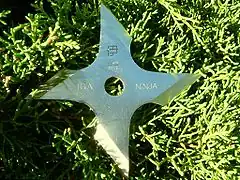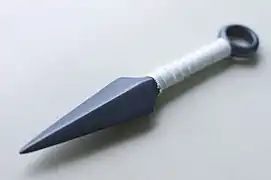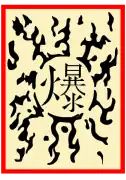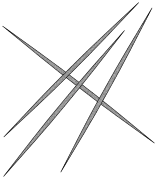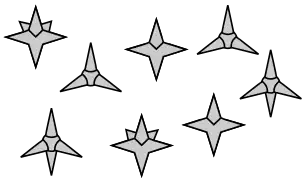Naruto Universe
The Naruto universe is a fictional universe created by Masashi Kishimoto, in which the story of the Naruto manga and related media takes place.
| Naruto Universe | |
|---|---|
| Genre | Science fantasy |
| Created by | Masashi Kishimoto |
| Based on | Ninjas and Samurai, epic battles |
| Original language | Japanese |
| Production | |
| Production location | Japan |
| Related | |
| Boruto | |
In the Naruto universe, which has many influences, the main protagonists are ninjas animated by a spiritual force called chakra, which enables them to use a whole range of fictitious combat techniques (jutsu), varying according to the user. In addition to this originality, the appearance of these ninjas is far from the usual stereotypes of feudal Japan, from which the series nevertheless borrows many notions, mixing them with some from Shintoism, Buddhism, or even Taoism and Hinduism.
Ninjas are organized in hidden villages, serving their country through various missions when not at war. Each village has its own internal organization, and the chief, the most powerful ninja in the village, called kage, has a certain autonomy, even if he is appointed by the daimyo, representing the country's civil command, and to whom he remains subordinate.
The hierarchy follows the rules of shōnen, where the young are trained by their elders.
Creation and design
Influences
In order to create characters as original as possible, Masashi Kishimoto looked to other shōnen manga.[1] In particular, he cites as an influence mangaka Akira Toriyama, creator of Dragon Ball, whose energetic, naive-thinking character, Son Goku (who represents for him "the archetype of a shōnen hero"), inspired the hero Naruto,[1] or the gaze games inspired by those of Son Gokû and Frieza.[2] Goku's "evil side" also inspired Naruto's (demon-possessed, with an unhappy childhood).[1]
Kishimoto also cites Toriyama's influence for his animal drawings; he believes that a good manga artist must also be a good animal artist, which is why the world of Naruto has a rich and varied fauna[3] (the animals appearing in the form of invocations are many representatives of this); he points out that he is particularly fond of dogs, which is why they play various important roles in the manga.[4]
The weapons that make up the varied arsenal of Naruto's world are also often inspired by those seen in other mangas.[5]
The author also mentions influences from the world of film and television, such as the Matrix movie, which he says he adores and which inspired certain costume elements, such as Gaara's, which comes up high on his neck during his appearances following the chūnin examination.[2] He also claims to have seen many films in director Kinji Fukasaku's Jingi series, liking the Japanese fashions and customs portrayed in these yakuza eiga (especially the master-student relationship[6]), and many drama series (tokusatsu) when he was young (inspiring him in particular with the concept of ninja "teams"[7]). The world of role-playing video games (RPGs) also inspired elements of the Naruto universe, such as the disparity in teams,[7] or the signs performed to create techniques, reminiscent of incantations.[8]
For his landscapes and costumes, the mangaka is sometimes inspired by China, liking to draw dragon statues,[6] or not hesitating to represent a toad in a Shaolin warrior monk costume;[5][9] but he is also influenced by the Japanese style, for certain drawings of trees or mountains in particular,[10][11] and was inspired by the clothes he wore as a child (notably to design Naruto's costume), liking clothes that are a little old-fashioned, but keeping a "cool" side. The landscapes of his childhood (in a "quiet village" in Okayama prefecture[12]) inspired some of his drawings of forests and rivers.[13][14] He says he often "visits Japanese gardens and attends kabuki sessions" to find inspiration.[15]
As far as gastronomy is concerned, Kishimoto draws as much inspiration from traditional Japanese food (ramen, dango, yakiniku...), as from the junk food of Western countries (chips, sodas, sweets).[16][17]
Creating the manga universe
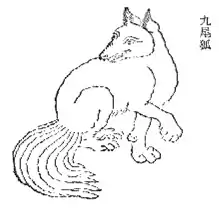
When Kishimoto thought about the setting for the Naruto manga, he first focused on the design of the hidden village of Konoha. Kishimoto claims that this design was created "quite spontaneously and without much thought", but admits that the landscape was inspired by the surroundings of his childhood home in Okayama Prefecture, Japan.[15]
Kishimoto has created Konoha without specifying a historical period (though he assumes it to be "close to today's") or a geographical location in relation to the real world, adding that the village's location is simply "a place out of [his] imagination". He does note, however, that if he were to define a climate and topography, it would be close to that of the city of Kyōto in Japan, this information being rather speculative, given that he has never visited that city.[15]
As the world of Naruto is a fictional universe, Kishimoto specifies that he had to "create certain non-negotiable rules" (such as restrictions on the use of weapons), and apply them systematically, so that the action flows smoothly.[15]
To build his universe, Kishimoto also likes to do his own research into Japanese culture, which he appreciates very much, and then make reference to it;[15] he also wanted to draw on Chinese astrology, which was very present in Japan.[18] Some legendary monsters from Shinto rites or Japanese tradition, such as the nine-tailed fox (kitsune), the Bake-danuki and the Bakeneko (three polymorphous entities), or the baku and Yamata-no-Orochi, appear in the narrative.
Some techniques also bear the names of major Shinto gods: Tsukuyomi, Amaterasu, Susanoo, Izanagi and Izanami; likewise, legendary objects such as the Kusanagi and Totsuka swords, and the Yata mirror.[nb 1] The tomoe symbol is also widely used in various forms throughout the manga.
The Sannin, for example, have similar names and characteristics to the characters in the Jiraiya Goketsu Monogatari tale... Similarly, the staff used by the 3rd Hokage, the result of a transformation of the "Monkey King" Enma, can change dimensions and is indestructible, like the weapon used by the monkey Sun Wukong, the main character in Wu Cheng'en's Journey to the West, which had already inspired Akira Toriyama to create Son Gokû.
Chakra
.svg.png.webp)
The chakra (チャクラ?), from the Sanskrit "wheel" or "disk" (चक्र), is in Naruto's universe an energy flow running through every living being via the meridians (経絡系, Keirakukei?),[19][20] a network of tiny channels like blood vessels. The chakra's circulatory system is present not only at the macroscopic scale, surrounding the internal organs described as "chakra-producing",[19] but also at the cellular level, linking nuclei to one another.[21]
Comparable to the ki (気?) of Taoism and used in the execution of jutsu, it is generated by the combination of bodily energy (身体 エネルギー, shintai enerugī?), created by the ninja's physical condition and training, and spiritual energy (精神 エネルギー, seishin enerugī?), created by willpower or intelligence.[22][23] Incantation signs can help knead and manipulate it.[20]
When "kneading" the chakra, every ninja has a natural sense of rotation around the axis of the body; this sense can be determined by observing the curvature of the hair at the top of the skull. Feeling one's own sense of chakra rotation requires a "sixth sense", but enables a ninja to avoid untimely interruptions to the flow of chakra when using ninjutsu.[24]
To justify the use of "special" powers, Masashi Kishimoto explains that he had to find a plausible explanation. So he invented a concept of "force" (similar to the concept of Star Wars, Ki in Dragon Ball Z or "magic points" in role-playing games), which he named chakra without having any particular affinity with East Indian mysticism.[8]
Chakra circulation
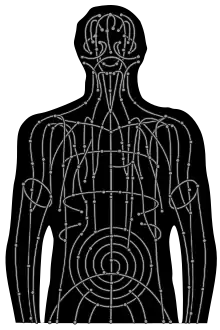

Chakra circulation is regulated throughout the body by 361 cavities (点穴, tenketsu?, lit. "vital points")[19] distributed along the meridians which, through precise manipulation, can increase or totally stop the flow.[nb 2] In addition, there are eight "gates", concentrations of vital points along the main meridian that act as real barriers to the flow's self-destructive force.[25]
- Gate of Opening (開門, Kai Mon?)
- Gate of Healing (休門, Kyū Mon?)
- Gate of Life (生門, Sei Mon?)
- Gate of Pain (傷門, Shō Mon?)
- Gate of Limit (杜門, To Mon?)
- Gate of View (景門, Kei Mon?)
- Gate of Wonder (驚門, Kyō Mon?)
- Gate of Death (死門, Shi Mon?)
By lifting psychic locks, concentration techniques can be used to break free from such limits and perform kinjutsu (禁術, forbidden techniques?) such as Lotus Flower recto or verso by opening doors. Such a practice naturally increases strength tenfold, but like many ultimate techniques, it is double-edged and the repercussions of opening gates are extremely severe for the user's physical condition. Opening the eighth gate is described as access to colossal strength, superior even to that of the strongest ninjas, but also as synonymous with death.[25] Rare ninjas like Gaï Maito, or Rock Lee, can lift psychic locks and open gates.
Godai Seishitsu Henka
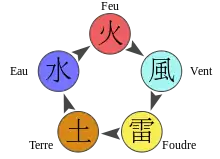
According to the manga universe, the execution of elemental ninjutsu requires the practice of Godai Seishitsu Henka (五大性質変化, Transformation of the nature of the five elements?),[26][27] consisting in changing the nature of the chakra into one of the five elements of Japanese tradition:[nb 3]
- fire (火, Hi?), which enables the use of Katon techniques (火遁, The Art of Manipulating Fire?);
- wind (風, Kaze?), which enables the use of Fūton (風遁, The art of manipulating wind?);
- lightning (雷, Kaminari?), which enables the use of Raiton (雷遁, The art of manipulating lightning?);
- earth (土, Tsuchi?), which enables the use of Doton (土遁, The art of manipulating earth?);
- water (水, Mizu?), which enables the use of Suiton techniques (水遁, The art of manipulating water?).
These elements are linked to each other by a sort of five-element rock-paper-scissors:[28][29] fire consumes wind; water extinguishes fire; earth absorbs water; lightning shatters earth; wind slices lightning. This circle of relationships is quite important, as practising a technique linked to an affinity means, of course, having a strength against a second element, but also a weakness against a third.[28]
Affinity

Each individual's chakra has a stronger affinity with one of the five basic elements:[nb 4] this particularity facilitates the manipulation of the element in question, and knowledge of one's affinity enables one to develop one's skills through specialization. Determining the element of greatest affinity requires the use of a special paper filled with chakra;[nb 5][30][31]
- if the paper burns, the chakra has a fire-type affinity;
- if the paper is cut, the chakra has a wind affinity;
- if the paper crumples, the chakra has a lightning-type affinity;
- if the paper disintegrates, the chakra has an earth-type affinity;
- if the paper gets damp, the chakra has a water affinity.
Although this practice only reveals the main affinity, knowing it is still very useful, since it means less chakra consumption and greater ease of execution.
It is impossible to use several elements simultaneously.[32] Only certain kekkei genkai and the fact of being a jinchūriki of an elementary bijū allow freedom from such a limit.[33]
Keitai Henka
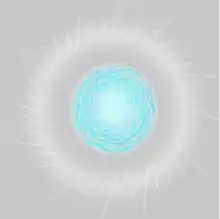
In addition to manipulating the nature of the chakra, there's another rarer manipulation called Keitai Henka (形態変化, Shape Manipulation?).[34] This manipulation consists in reshaping the chakra to give it a special shape visible to the naked eye. Achieving a transformation of nature and form at the same time is presented as difficult because it requires concentration on two opposing things at once, like "looking left and right at the same time".[35][36]
Two examples are cited in the course of the manga: the "Thousand Birds" technique - named for the characteristic chirping-like sound it produces - which was created by Kakashi Hatake and involves giving chakra the form of blue lightning as well as changing nature to lightning; and the "Swirling Orb" created by Minato Namikaze, which takes the form of a swirling orb of chakra in the palm of the hand without changing nature. This is described as the perfect keitai henka by Kakashi Hatake.[35]
The second technique is passed on to the hero by Jiraya, and the first is taught to Naruto's nemesis Sasuke by Kakashi, who created this technique based on the second.[37]
Yin and yang
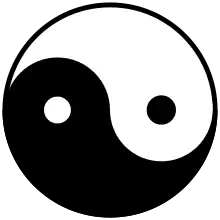
Yin and yang is a Taoist concept representing a philosophical vision where each thing and its opposite are found in all aspects of life and the universe within a symbiotic and complementary relationship. Among other things, yin (陰, Japanese for 'in'?) represents the negative aspects of everything, while yang (陽, Japanese for yō?) represents its positive aspects. They can also represent the body and mind respectively.
In the Naruto universe, techniques or disciplines such as "shadow manipulation", "decupling", ninja medicine or genjutsu are implicitly described as being linked to the balance between the yin and yang of the chakra,[32] or between its physical and spiritual energy.[38] According to the precepts of Taoism, yin cannot go without yang and vice versa; however, techniques such as Tayuya's chakra spectra, which exploits a voluntary imbalance in the chakra, render it unstable, allowing it, for example, to devour the energy it lacks.[38]
This balance is also present in the chakra reservoirs that are the Tailed Demons, Minato Namikaze having sealed, according to Jiraya, only the yang part of the Kyûbi in his son's body.[39]
Sage mode
.svg.png.webp)
Sage mode is a different form of chakra that enables the practice of senjutsu (仙術, hermit techniques?).
In addition to bodily and spiritual energy, hermit chakra kneading requires "natural energy" (自然•エネルギー, shinzen enerugī?) that must be perfectly balanced with the other two (by controlling the flow of natural energy into and out of the body), or else you'll first turn into a toad, then merge with nature to the point of becoming stone,[40] resulting in a giant toad statue, made of stone. However, senjutsu is not a technique exclusive to toads; snakes have also mastered it.
Unlike ordinary chakra, the kneading of such a chakra requires "becoming one with nature", which calls for perfect concentration and immobility, plunging the "hermit" into deep meditation and thus putting him at risk as long as he balances energies (he is exposed in the event of an attack).[41] However, once the sage stage has been reached, the ninja increases his power and strength tenfold.
Whereas previous concepts were inspired by Taoism, and more specifically by yin and yang and the symbol taijitu (太极图, taìjítú), senjutsu is inspired by the Buddhist concept of trikāya and the symbol gankyil.
Jutsu
Jutsu (術, techniques?) are the very essence of ninpō in the Naruto manga. They are combat or support techniques that represent the application of know-how that can only be acquired after long training aimed at developing and controlling one's physical and spiritual resources.
They can be purely physical, like the repertoire of Taïjutsu (体術, the art of hand-to-hand combat?) or that of Kenjutsu (剣術, the art of sword fighting?), or rely on the ninja's mental strength through chakra modulation and transformation, like the repertoire of Genjutsu (幻術, the art of illusions?) or that of Ninjutsu (忍術, the art of the ninja?).
According to the IGN website, Jutsu are one of the most entertaining concepts in Naruto, due to their incredible diversity. The complicated signs required for these techniques, the unique physical features and the sheer destructive power of Ninjutsu are the elements that have made the series so popular.[42]
An important part of the series' Databooks is dedicated to this, providing a meticulous listing of these Jutsu, along with numerous technical details.[43][44][45]
Basic techniques
Basic techniques are those taught at the ninja academy and supposed to be mastered by all ninjas who have obtained the rank of genin. They are ranked "E" (lowest). These techniques include:
- the Cloning Technique (分身の術, Bunshin no jutsu?) where the user creates inconsistent clones of himself.
- Metamorphosis (変化の術, Henge no Jutsu?)[46] where the user takes on the appearance of a person, animal or object.
- the Permutation Technique (変わり身の術, Kawarimi no Jutsu?)[47] involves permuting something (your body, or someone else's) with something else (usually a log).
- the Technique for untying ties (縄抜けの術, Nawanuke no Jutsu?)[48] consisting in untying oneself when bound hand and foot.
Ninjutsu
Ninjutsu is the art of the ninja.[49] This type of technique usually consumes a large amount of chakra. It makes abundant use of the nature of chakra and requires the ability to "knead" it correctly.
Incantation signs
Incantation signs are manual movements called Mudrā (or Tao), necessary for the execution of Ninjutsu. Indeed, to perform a technique, a ninja must not only knead chakra in specific areas of the body, but also perform a sequence of signs (each technique having a different sequence).[50]
Note: The number of signs to be performed is not proportional to the complexity or power of the technique.
The 12 basic signs come from the Chinese horoscope.
According to Masashi Kishimoto, he developed this system as an alternative to verbal incantations for casting spells in RPGs.[8] The author also explains that he enjoys drawing hands and fingers.[3]
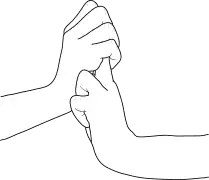 Rat Mudrā
Rat Mudrā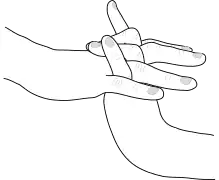 Buffalo Mudrā
Buffalo Mudrā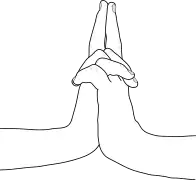 Tiger Mudrā
Tiger Mudrā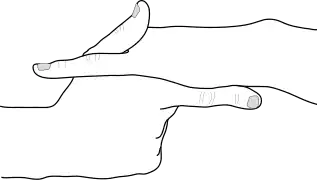 Hare Mudrā
Hare Mudrā Dragon Mudrā
Dragon Mudrā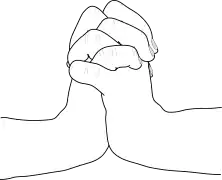 Snake Mudrā
Snake Mudrā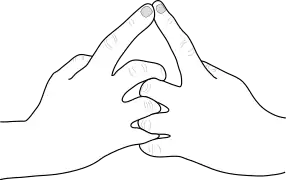 Horse Mudrā
Horse Mudrā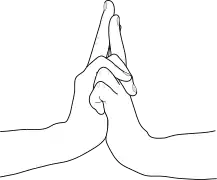 Goat Mudrā
Goat Mudrā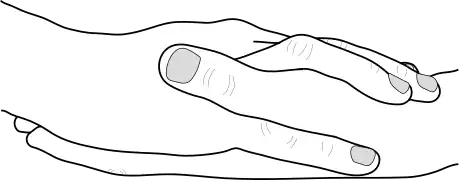 Monkey Mudrā
Monkey Mudrā Rooster Mudrā
Rooster Mudrā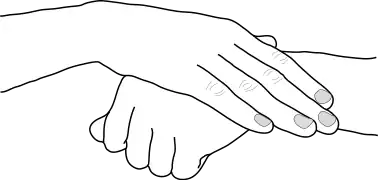 Dog Mudrā
Dog Mudrā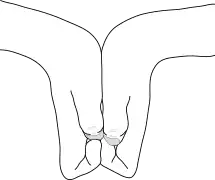 Pig Mudrā
Pig Mudrā
There are also signs specific to certain techniques, such as the modified goat of "Multi cloning" (learned by Naruto Uzumaki in the very first chapter of the manga):
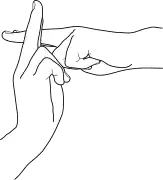 Multi-cloning Mūdra
Multi-cloning Mūdra
Invocations
The art of summoning is a branch of Ninjutsu that enables you to summon living beings or objects using the Kuchiyose no Jutsu technique (口寄せの術?).
When summoning creatures, the summoner must first sign a contract in his own blood, binding him to the creature(s) to be summoned.[51] He may then, when he wishes, summon a creature with whom he has made such a pact, by offering a few drops of his blood and performing the appropriate Mudrā (Pig - Dog - Rooster - Monkey - Goat).
Summoning objects does not require blood, but requires the use of scrolls or special tattoos.
Hereditary techniques
Hereditary techniques (血継限界, kekkei genkai?, lit. "echnique limited to inheritance by blood") are techniques that are transmitted from generation to generation and are inaccessible to other ninjas.[52]
There are three main categories: Dōjutsu, literally the art of using the pupils, fusions of elements enabling the use of unique elementary techniques, and all other hereditary techniques that do not fall into the previous categories due to their unique specificities, sometimes limited to a single ninja.
Some techniques can be considered hereditary, as they are used by a single clan, but are not transmitted by blood: these are the "secret techniques" (秘伝, hiden?)[53] the use of which is only taught within a single clan. These include the Nara clan's shadow manipulation techniques, the Akimichi clan's techniques for decupling all or part of the body, the Aburame clan's insect manipulation techniques, and the Yamanaka clan's mind manipulation techniques.
One extremely rare and powerful hereditary technique is Kekkei Tôta. This technique blends three chakra affinities, whereas a kekkai genkai blends only two. Kekkai tôta is only possessed by two people known in the Five Great Nations: the second Tsuchikage, Mû, and the third, Ônoki. Their chakra nature is Jinton, the art of controlling dust.
Senjutsu
Senjutsu (仙術?) is a branch of Ninjutsu that represents all techniques using the sage mode chakra. These are generally classic techniques, but boosted in power by "natural energy".
This art is notably practiced by the hermit toads living on Mount Myôboku (妙木山, Myōboku Zan?).
It is also used by several ninjas in the manga, such as Jiraya and Naruto Uzumaki, who learned it from toads.
At Mount Myôboku, under Fukasaku's tutoring, Naruto's training followed three stages.
- First of all, he had to master the accumulation of natural energy with the help of toad oil, which has the power to attract natural energy. This part of the training is very dangerous, as the neophyte is very quickly overtaken by natural energy and turns into a toad.[40] His master must use a stick capable of absorbing this energy to ensure that his pupil does not pass the point of no return, by hitting him violently with the stick at the start of the transformation. As oil is only consistent on Mount Myôboku (it evaporates as soon as it leaves its atmosphere), there's no point in thinking about taking it into the ninja world to use it and thus facilitate the accumulation of natural energy.[54]
- The next step is to accumulate and balance natural energy without oil (by controlling the inflow and outflow), which requires perfect immobility and communion with nature. To help Naruto achieve perfect immobility, Fukasaku places him on a stone slab balanced on a rocky outcrop in a position close to the lotus position. When this stage is complete, the hermit pigmentation appears around the eyes.[55]
- Finally, we must learn to use natural energy in combat, in particular the "toad kata" (an extremely fast taijutsu).[41]
Naruto has managed to balance the three chakras perfectly, thanks in particular to his phenomenal amount of "classic" chakra.[55] Jiraya, on the other hand, has not fully achieved this, and consequently turns into a bit of a toad when he switches to "sage mode".[40]
A ninja in "sage mode", because he uses natural energy, recovers more quickly.[56] He can also feel the chakra of all living forms in a wide perimeter.[56]
The great risk of "sage mode" is the period of immobility required, which leaves the ninja at the mercy of his opponent; successfully switching to this mode therefore requires allies who can "buy time".[41] The other problem is that a ninja fighting in this mode is no longer immobile, and therefore no longer gathers natural energy; he can therefore only use senjutsu for a period of approximately five minutes. To overcome this problem, the toads of Mount Myôboku use "fusion": a fused toad on the ninja's shoulder gathers natural energy, thus prolonging the "sage mode".[41]
Unable to fuse because of Kyûbi,[57] Naruto uses another stratagem based on "Multi-cloning", letting clones accumulate natural energy at Mount Myôboku and summoning them as needed to recover their energy by dissipating it.[58]
Later in the series, the use of senjutsu is encountered in other characters, whether mastered (Kaguya and her direct descendants, Kabuto, Hashirama Senju) or not (members of Jûgo's clan).
Genjutsu
Le Genjutsu is the art of illusion and artifice.[59] This technique involves manipulating the synaptic connections in the brain to disrupt the perceptive organs. These perceptual disorders are caused by the injection of chakra into the brain. This type of technique requires a high intellectual level.[60] Ninjas who have mastered Genjutsu can lure their opponents by playing on their environment. The victim is then plunged into a sort of waking dream: he or she has the impression of perceiving, hearing and smelling things. In this way, the ninja can dominate his opponent by manipulating him.
Taijutsu
Taijutsu is the art of hand-to-hand combat.[59] Taijutsu therefore refers to all martial arts techniques or those involving the ninja's body in close combat. It involves physical strength and speed of movement.
This type of technique doesn't usually use chakra; it's usually a combination of punches, kicks, blocks, jumps, agile movements and parries. However, the addition of chakra has the ability to perfect or strengthen a technique.
In Naruto's world, there are two branches of Taijutsu: the Gōken and the Jūken.
The 4th Raikage, as well as his father the 3rd Raikage, also use a special ninja style, Nintaijutsu, which combines elements of Ninjutsu (such as covering the body with a lightning-like envelope of chakra) and Taijutsu (powerful physical attacks combined with Ninjutsu techniques).
Gōken
Le Gōken (護 憲?, lit. Hard fist) is the most widespread fighting style. It involves inflicting external physical damage such as fractures or bruises.[61] Most ninjas practice this style, but the real specialists in this field are Maito Gai and his disciple Rock Lee, whose name and style (notably the "drunken man technique", or Zui quan) are inspired by Bruce Lee.
Jūken

Le Jūken (柔 拳?, lit. Flexible fist) is a fighting style known only to the Hyûga clan. It can only be practiced with Byakugan, as it requires a perfect view of the meridians and chakra cavities (tenketsu). It inflicts internal damage by applying pressure to the tenketsu, which reduces or stops the flow of chakra.[61] As the chakra circulatory system is entangled with the internal organs, a simple disruption can cause heavy damage.
Some Jūken techniques are based on a "divination circle" consisting of a bāguà to which is added an outer circle adorned with kanji representing 8 of the 24 key characters of the Ba Gua Zhang. The Hyûga places himself at the center of the circle in a particular position, enabling him to strike certain points with unrivalled precision and speed, whether to defend himself (deflecting or countering projectiles, for example), or to attack (one of these techniques in particular enables him to strike the opponent's 64 Tenketsu very quickly, completely blocking the circulation of his chakra).[62][63]
Seals

The art of seals, known as Fūinjutsu (封印術?) is an art that allows you to imprison entities in a body or on a scroll, but also to act on the physical and mental abilities of an individual on whom the seal is affixed.[64] A seal leaves a specific mark (a kanji, a tomoe...) on the body or scroll used.
Jūin Jutsu (呪印術?) is a derivative art concerning anathematized seals.[64] This type of technique consists in acting in a harmful way on the physical and mental dispositions of the sealed individual, by adding a special power for example, as in the case of Orochimaru's Cursed Mark (Kubiwa), or by limiting his abilities, as in the case of the swastika (representing a stylized caged bird), in the Hyûga of the bunke (secondary branch of the family), or the seals used by Danzô Shimura.
Creating a seal sometimes requires lengthy preparation and a special ritual, as when Kakashi Hatake attempts to contain the cursed mark placed on Sasuke Uchiha,[65] or when Jiraya seals the fire of the "Celestial Light" (Amaterasu).[66]
Kinjutsu
Forbidden techniques (禁術, Kinjutsu?) are a class of techniques that are prohibited[53] because they are deemed extremely dangerous for the user (classified as S rank), or unethical (such as Naruto and Konohamaru's "Sexy-Meta", which consists of taking the form of a naked young woman with generous, enticing forms). These techniques, secretly protected by the Kage himself in scrolls, were defended for reasons specific to the technique. For the ninja of a village, it is theoretically forbidden to exploit or profess such knowledge unless crucial events occur. Ninjas mastering such Jutsu are few and far between...
Some ninjas specialize in this type of technique, such as Orochimaru, who masters a large number of them, including some he invented himself, and does not hesitate to use them.
History and legends
Kaguya Ôtsutsuki
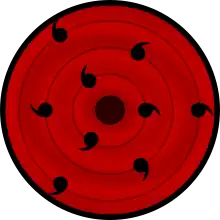
According to the legend inscribed on the Uchiha sacred stone stele in the basement of the Nakano Shrine (南賀ノ神社, Nakano Jinja?), the clan's secret meeting place, the chakra comes from a divine tree called Shinju (神樹?, lit. "Tree God"). Once every thousand years, this tree produced a fruit that was forbidden to touch.[67]
With the world of men ravaged by war, a princess named Kaguya Ôtsutsuki (大筒木かぐや, Ōtsutsuki Kaguya?) from another planet, arrived to protect herself from other unknown beings. She arrived in the land of So. The lord of this country was a young man who deeply respected Kaguya because she possessed the Byakugan. She could also violently push people away from her and cut them to pieces. As the country of So was persecuted by the country of Ka and the latter was 3 times more powerful militarily, the lord forbade attacking the people of Ka. The lord of Ka wanted to kidnap Kaguya, and Kaguya ignored the recent rule, so she defended herself. The lord of Ka reported this to the lord of So, who pursued Kaguya, unaware that she was carrying their children. Kaguya's servant was killed, having been carried off by her mistress as she fled. Kaguya then became Jinchuriki of Shinju and launched the Infinite Lunar Arcana. She thus became the first person with chakra. She was feared and worshipped by humans as "rabbit goddess" (卯の女神, Usagi no Megami?) or "demon" (鬼, Oni?).
The princess later gave birth to two dizigote twins, sons of the lord of So, Hamura (ハムラ?) and Hagoromo (ハゴロモ?) ater known as the "Sage of the Six Paths" (六道仙人, Rikudō Sennin?) and who inherited the chakra.[68]
Jealous that her sons had inherited the chakra, she merged with the Shinju to rise up against them in the form of the ten-tailed demon Jûbi. At the end of the battle, Hamura and Hagomoro managed to separate Kaguya's chakra and seal her body, the "statue of the Demon of the Underworld", creating the Moon. Hagomoro sealed Jûbi's chakra within himself, and remained on Earth to distribute the chakra to humans and teach them ninshu, while Hamura and the rest of the Ôtsutsuki went to the Moon to watch over their mother's body. The latter, just before being sealed, managed to create an entity from her will in order to organize her return.
Hagoromo Ôtsutsuki
The Sage of the Six Paths (六道仙人, Rikudō Sennin?), real name Hagoromo Ôtsutsuki (大筒木ハゴロモ, Ōotsuki Hagoromo?), is a legendary figure, known for creating the ninja world and ninjutsu[69] (actually, "ninshû" (忍宗, lit. "ninja teaching"?), created to inspire hope, ninjutsu being a derivative creation dedicated to war[68]). He possesses the most powerful dōjutsu (technique using the eyes) there is, Rinnegan.
Until his appearance at the end of the 4th Great Ninja War, he is represented as a silhouette with only his eyes visible (revealing his pupils), and wears a necklace with six symbols representing the six paths of reincarnation. When Naruto meets him in his mind, he has horns linked to his mastery of Senjutsu, long white hair and a beard that reaches down to his belly and ends in a point; he has the five concentric circles of the Rinnegan tattooed on his forehead and holds a black staff with a truncated ring at one end, and a full ring at the other end onto which six smaller rings are threaded.[68]
The sage possesses a powerful creative power called "Izanagi", based on the "Creation of All Things (万物创造, Banbutsu sōzō?)" combining spiritual energy (yin) to give form from nothing, and physical energy (yang) to breathe life into these forms, a power used to give shape to the imaginary.[70] This technique is used in some form by Danzô Shimura and Madara Uchiha to achieve temporary invulnerability by combining the powers of the Sharingan with those of the First Hokage to fuse illusion and reality, enabling them to ignore the consequences of any attack; the Sharingan that serves as the conduit for this power is struck blind and loses its abilities.
According to Jiraya, the Sage wanted to bring peace and order, saying that ninshû was a power of the heavens, the tool of the gods, and that it could bring peace to a chaotic world, or, if misused, completely destroy it and turn everything to dust.
For Madara Uchiha, even if it's only a myth, the story is based on real elements,[71] which were finally confirmed by the appearance and revelations of the Sage himself at the end of the 4th great ninja war.
The Sage was the first jinchūriki in history, having sealed in his body Jûbi, the ten-tailed monster at the origin of the bijū, thus saving the world from the latter's destructive power.[72] Thanks to this action, he was revered by the people as a god. Madara even described him as a superman, due to his extraordinary power and abilities.
From his descendants would come the Senju and Uchiha clans, who together founded the first hidden village of the "ninja world" (Konoha), thus initiating the political structure that would bring stability to it.
The story of his heirs
The story of the Sage's heirs is told by Zetsu to Naruto and Sasuke:
The Sage is said to have had two heirs; sensing his end coming and having failed to fulfill his dream of world peace, he bequeathed his hopes and power to them. The elder received the Sharingan, a powerful chakra and great spiritual energy; his idea of peace lay in power. The younger son received the Sage's strength and physical energy (an abundant chakra), as well as his will; his idea of peace lay in love. The Sage chose the younger son to succeed him, after putting them to a test, unwittingly creating a destiny of hatred between the two lineages, despite the weakening of their powers over the generations. The Uchiha descend from the elder, while the forest Senju descend from the younger.
When Naruto meets the Sage in his mind, the latter tells him a slightly different, more detailed version of his children's story:[68]
The Sage had two sons; the elder, Indra, was a genius who had inherited his father's chakra and eyes, and his facility and keen sense of combat led him to believe that anything was possible with his power; the younger, Ashura, was a failure who could do nothing without long effort and the help of his comrades. Over time, however, Ashura's inner chakra blossomed, and he acquired power equivalent to that of his brother, but understood that his strength came from his comrades and what it meant to care for others; he eventually concluded that it was love, not power, that was the driving force behind making everything possible. Watching his two sons evolve, the Sage came to understand in his turn that creating bonds and cooperating with his comrades was the true path to power; he created the tailed demons and made his youngest son the heir to ninshû, hoping that his brother would join him, but the latter did not accept, secretly encouraged by the black entity originating from Kaguya to start a fratricidal war. When both brothers' bodies were destroyed, the chakra they possessed did not evaporate, but was reincarnated from generation to generation; Hashirama Senju and Naruto thus became the last incarnations of Ashura, and Madara Uchiha and Sasuke, those of Indra.[68]
The Uzumaki, Forest Senju, Hyûga, Uchiha and Kaguya clans carry many of the genetic traits of the sage, his brother and his mother.
The precious tools of the Sage
The precious tools of the Sage of the Six Paths (六道仙人の宝具, Rikudō Sennin no hōgu?), are five objects used according to legend by the Sage:[73]
- the "golden rope" (幌金縄, Kōkinjō?) used to bind the target and extract its soul.
- the "seven-star sword" (七星剣, Shichiseiken?) used to curse the soul.
- the "scarlet gourd" (紅葫蘆, Benihisago?) for recording and sealing the soul.
- the "palm-leaf fan" (芭蕉扇, Bashōsen?) which enables the use of the five elemental natures.
- the "amber vase" (琥珀の浄瓶, Kohaku no jōhei?) which seals a person who responds to its name when called.
Their use consumes enough chakra to kill an average ninja quickly, so only a phenomenal reserve of chakra allows them to be used repeatedly.
These five objects were all once in the possession of the Land of Lightning, but were stolen by the deserting brothers Kinkaku and Ginkaku; the last was recovered by the village of Kumo and used to seal Hachibi when he gained the upper hand over a host.
In the traditional Chinese novel The Journey to the West, there are similarly named objects used by two demonic antagonists called in Japanese Kinkaku-daiō (金角大王?, lit. Great King with Golden Horns) et Ginkaku-daiō (銀角大王?, lit. Great King with Silver Horns).
Tailed demons
Tailed demons, also known as bijū, are mystical beings created by the Sage from Jûbi in order to divide the latter's power. They are very powerful, made of chakra and occasionally cause damage in the ninja world.[74][75]
To prevent them from doing harm, as well as to recover their powers, ninjas use a technique to seal them inside a person then called a "host" (or jinchūriki).[76]
Representing a destructive weapon of great power, they are the object of much covetousness in the "ninja world".[76]
Ninja organization
Geopolitics
The geopolitics of Naruto's world is heavily borrowed from the remnants of feudal Japan. The "ninja world" is divided into several countries governed by a daimyo; each country has a military force represented by a hidden village[nb 6] commanded by the village's most powerful ninja, the Kage.[77] Alliances, wars and friction between the various countries and villages are commonplace, providing the story's protagonists with a wide variety of adventures.
Konoha, the village where the main characters live, is at the center of the Land of Fire, the most powerful of the five great countries. When the action begins, the village is in a period of peace and prosperity.[78]
In times of peace, certain events, such as the examination to pass the chūnin rank, are sometimes pooled between allied countries, in order to promote friendship between these countries and provide a substitute for war. These events also serve to demonstrate the military strength of the village and the potential of its generation of young people undergoing real training.[79]
Civil world
The civilian world in the Naruto universe is pretty much the same as ours. Ninjas benefit from the same technologies, live as a family, and have conventional activities[80] (we even see them go to the movies in the film Naruto the Movie: Ninja Clash in the Land of Snow produced by Studio Pierrot)...
According to Masashi Kishimoto, the only exception to this "modern world" is the use of weapons and explosives. The author decided to use weapons from an earlier era.[8] He also rejected the use of firearms, considering that ninjas wouldn't stand a chance against them, even if certain techniques sometimes seem similar. Likewise, he rejects all other technologically advanced weapons, such as missiles, which he believes would detract from the interest of the story.[nb 7][15] The explosives used are specific to the series, such as explosive scrolls or Deidara's explosive clay. The anime also sometimes introduces much more modernity than the manga.
Kishimoto also prefers not to introduce vehicles such as airplanes,[15] as the transportation industry remains underdeveloped (the ninjas travel mainly on foot, or in rudimentary boats when crossing bodies of water). Nevertheless, some advanced means of transport have been seen in the series' companion films.
As far as computers are concerned, Kishimoto specified that computers in the Naruto universe would remain very basic, leaving open the possibility of introducing 8-bit technologies, but excluding 16-bit technologies.[18] Cameras and video cassettes are used to monitor the entrance to the central tower during the Forest of Death test in the Chûnin exam.
In addition to their military activities, the hidden villages have a fairly well-developed industry and internal trade, which seems to be enough for them to live self-sufficiently. Kishimoto notes that, even if you've never seen it, there's bound to be a grocery store in Konoha (in reference to everything the young ninjas buy, such as Chôji's potato chips).[17]
Konoha also has a general hospital for civilians, foreigners and ninjas (although medical techniques are more advanced than ours, thanks to chakra, and doctor ninjas can, for example, use techniques that considerably speed up the cell regeneration process in the event of serious injury[81][82]); however, there doesn't seem to be any teaching structure other than the military academy. Konoha also has a library.[83]
Military Academy
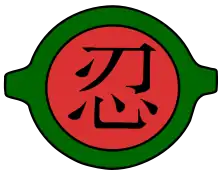
The military academy is the school attended by all future ninja.[84] It teaches the basics of ninjutsu: weapon handling (kunai and shuriken), chakra control, basic techniques (substitution, metamorphosis and cloning) and the fundamental rules of ninja.[80] Students are not considered full-fledged ninjas, and are therefore not allowed to wear a headband until they are promoted to the rank of genin.[84] This promotion is obtained through an end-of-year examination, the modalities of which vary from one ninja village to another. In Konoha, it consists of a written knowledge test and a practical test such as the execution of a cloning jutsu.[84] In Kiri, they used to be duels to the death between students, a ritual abolished when a child not even attending school, Zabuza Momochi, killed a hundred students in one class.[85]
At the end of the academy exam, students are grouped in threes and placed under the tutelage of a jōnin.[86] The latter tests his new recruits and decides whether he will train them; indeed, only a third of the students who pass the exam will actually be accepted as genin at the end of these tests, the others having to return to the academy for another year.[87] A team cannot be divided, so they must pass together, or they will all fail. The key to the test is teamwork.[88]
Police forces
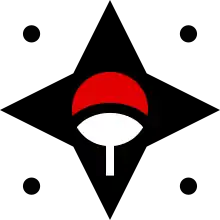
The Konoha village police force, made up of members of the Uchiha clan, was created on the initiative of the 2nd Hokage Tobirama Senju.[89]
The police force's job is to ensure the peace and quiet of the population by enforcing order in the village,[90] including investigations (as in the case of Shisui Uchiha's murder disguised as suicide[91]). Their symbol is a stylized four-pronged black shuriken bearing the clan emblem.[90] Their last captain was Fugaku Uchiha, father of Sasuke and Itachi.[91]
According to Tobi, the Hokage, who belonged to a former enemy clan with the Uchiha clan, created these police forces with the sole aim of making the latter forget that they had been ousted from power following their alliance that led to the creation of the village.[89]
The police force was completely annihilated the night Itachi wiped out his entire clan, with Tobi's help, leaving only his younger brother Sasuke Uchiha alive.[92]
Ninja hierarchy
All working ninjas, from academy graduates to retirees, have a rank. This rank determines their functions in the village and the tasks they can perform.[77]
Genin
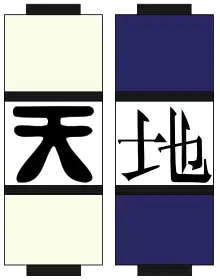
Les genin (下忍, Ninja de classe inférieure?) are ninja apprentices. After graduating from the academy, they continue their training in the field. They are generally divided into teams of three, under the responsibility of a jōnin who passes on his experience and teaching, while ensuring their protection. They are officially village ninjas, and may wear the headband. They contribute to the village economy by carrying out routine, low-risk missions (D-rank missions, or more rarely C-rank missions).
When the jōnin deems that the genin in his charge have acquired sufficient experience, he may submit their application for the chūnin examination.[93]
Unlike jōnin and chūnin, genin do not wear regulation uniforms, although some ninjas of this rank seem to wear a kind of uniform reminiscent of their village uniform.
Chūnin
Chūnin (中忍, middle-class ninja?) are experienced ninjas. The status of chūnin corresponds to the responsibility of team leader (usually a group of three to four ninjas).[94] The examination for the passage from genin to chūnin comprises three eliminatory tests: a test of will, a test of survival, and a final phase during which a jury composed of lords and great ninjas (such as the Kazekage and the Hokage) designates, independently of the fights that make it up, the genin most suitable to bear the title of chūnin. Intellect and maturity seem to be more essential criteria than strength for chūnin; thus, Shikamaru Nara will become chūnin without having defeated Temari in his fight.
With the exception of Naruto, who left to train with Jiraya outside the village, and Sasuke, who left the village to follow Orochimaru, most of the young genin in Konoha passed the chūnin exam during the two and a half years between the first and second parts of the manga.
From the rank of chūnin onwards, ninjas from the five major villages wear the uniform of their village, a copy of which (the green vest, for Konoha) is given to them on promotion.
Special Jōnin
Special jōnin (特別上忍, Tokubetsu jōnin?) are ninjas who, due to their specialization for a particular set of tasks, have only developed their abilities in a particular field and consequently lack the level to claim the rank of jōnin without being chūnin.[95] This is an intermediate grade reflecting both their highly developed abilities in their fields but relatively weak in others.
Examples include:
- Hayate Gekkô, referee during the preliminary matches of the chūnin exam;
- Ibiki Morino, head of Konoha's interrogation and torture section, and occasional examiner during the first round of the chūnin exam;
- Raidô Namiashi, assigned to liaise between the Hokage and other ninjas during the third round of the chūnin exam;
- Genma Shiranui, referee during the third round of the chūnin exam;
- Ebisu, Konohamaru's private teacher;
- Anko Mitarashi, examiner during the second round of the chūnin exam.
Jōnin
Jōnin (上忍, High-class ninja?) are elite ninjas. The jōnin are the best ninjas in their country, and are the ones sent to wars to govern the military troops.[95] They carry out the most delicate and perilous missions (A or B rank) such as assassinations or espionage. The transition from chūnin to jōnin is not made by examination, but only when other jōnin or the Kage deem the ninja fit to become one. The jōnin are also responsible for genin training. In Konoha, they also have a certain importance for the politics of their village, as the choice of a new Kage must first be approved by a vote of the village's jōnin before becoming official.
Among the jōnin at the beginning of the series are:
- Kakashi Hatake;
- Gaï Maito;
- Asuma Sarutobi;
- Kurenaï Yûhi;
- Hiashi Hyûga;
- Shikaku Nara;
- Inoichi Yamanaka;
- Chôza Akimichi;
- Shibi Aburame;
- Tsume Inuzuka.
ANBU

ANBU (暗部, Hidden Face?) is a blend word made up of the Japanese words Ansatsu Senjutsu Tokushu Butai (暗殺戦術特殊部隊, Special Tactics and Assassination Squad?). This is a special unit created to serve as the kage's personal guard.[96][97]
The word ANBU is used to designate both the unit and its members.
ANBU are recruited from among the ninja elite. They are also in charge of the most perilous missions (assassinations, escorts, espionage), usually traveling in squads of three or four led by a team leader (when not on individual missions).
They are under the direct authority of the kage, and answer only to him (except in the case of the ANBU Root). Because of their responsibilities and the secrecy of their missions, ANBU wear a pseudonym and a mask bearing the effigy of an animal, a demon (as for the Land of Wood), or a simple oval (as for the village of Kiri), sometimes with single-colored decorations.
ANBU are identified by a tattoo on the left bicep, and their uniform is unique. They are equipped with metal plates protecting the forearms, light armor protecting the torso and back, gloves with metal plates, sandals with reinforced soles, a katana worn on the back and a mask.
ANBU ninjas include:
- Kakashi Hatake, ex-ANBU;
- Yûgao Uzuki;
- Yamato (Tenzô);
- Itachi Uchiha, ex-ANBU leader;
- Ibiki Morino, Head of torture and interrogation section;
ANBU Root

L’ ANBU Root (根暗部, Ne Anbu?) is a parallel branch of Konoha's ANBU, created and led by Danzô, a fierce supporter of the war, opposed to the 3rd Hokage.[98] It is an independent training section within the ANBU. In the Root group, ninjas have neither names nor emotions, neither past nor future, but only their mission.
This division was eventually disbanded by the 3rd Hokage. Despite this, the ANBU Root continued to operate in the shadows (as evidenced by Sai's arrival in Team 7, following Sasuke's defection).
The members of the Root define themselves as follows: "What makes the tree that is Konoha strong, and invisible from the outside, are the roots that we are". They are all branded on the tongue with a Danzô seal preventing them from talking about the organization's actions (whether freely or under duress): as soon as they begin to reveal things about the Root, their bodies are completely paralyzed. On Danzô's death, this seal will disappear, and the Root will be dissolved.
Kage
Kage (影, lit. "shadow"?) is the title given to the leaders of the hidden villages of the "five great countries".[nb 8] Although this title may sometimes seem hereditary (the 5th Hokage is the granddaughter of the 1st Hokage whose brother is the 2nd Hokage, and Naruto will succeed the 4th Hokage who was his father, and similarly, Gaara will succeed his father the 4th Kazekage), it is passed on to the most powerful ninja in the village, his main role being that of "protector".
These men or women are officially the five most powerful ninjas in the ninja world; together, they have a monopoly on the ninja business.[77] In the event of a crisis affecting the entire "ninja world", they can gather in a neutral territory, the Land of Iron, and discuss matters in an assembly called the "Council of Five Kage", with each Kage accompanied by two bodyguards from his or her village. The meeting is chaired and moderated by a senior Iron Country official.[99]
The title and role of the Kage appear to be quite similar to those of the shogun in Japanese history, with the Kage having a greater presence than the daimyō of their own countries in the latter's foreign policy.
Titles
The Kage's title is always preceded by the element of the country housing the hidden village he leads, which gives the following appellations:[77]
- Master Hokage (火影, lit. Shadow of Fire?) is the ruler of Konoha, the hidden village of the leaves of the Land of Fire;
- Master Kazekage (風影, lit. Shadow of Wind?) is the ruler of Suna, the hidden village of sand in the Land of Wind;
- Master Mizukage (水影, lit. Shadow of Water?) is chief of Kiri, the village hidden in the fog of the Land of Water;
- Master Raikage (雷影, lit. Shadow of Lightning?) is the ruler of Kumo, the village hidden in the clouds of the Land of Lightning;
- Master Tsuchikage (土影, lit. Earth Shadow?) is the leader of Iwa, the hidden village of rock in the Land of Earth.
Hats
The Kage is easily recognized by the special hat he wears, bearing the kanji of his country.
- Here are the Kage hats, as they appear in their very first appearance, at the beginning of the anime.
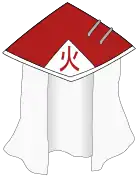 Hokage hat as it appears at the beginning of the anime.
Hokage hat as it appears at the beginning of the anime.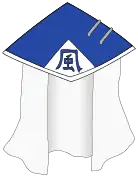 Kazekage's hat as it appears at the beginning of the anime.
Kazekage's hat as it appears at the beginning of the anime.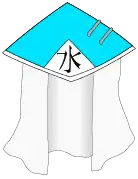 Mizukage hat as it appears at the beginning of the anime.
Mizukage hat as it appears at the beginning of the anime.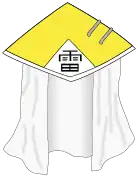 Raikage hat as it appears at the beginning of the anime.
Raikage hat as it appears at the beginning of the anime. Tsuchikage's hat as it appears at the beginning of the anime.
Tsuchikage's hat as it appears at the beginning of the anime.
- Here are the Kage hats, as depicted in the Naruto Shippuden anime.
 Hokage hat as it appears at the beginning of the anime.
Hokage hat as it appears at the beginning of the anime..svg.png.webp) Kazekage's hat as it appears at the beginning of the anime.
Kazekage's hat as it appears at the beginning of the anime..svg.png.webp) Mizukage hat as it appears at the beginning of the anime.
Mizukage hat as it appears at the beginning of the anime..svg.png.webp) Raikage hat as it appears at the beginning of the anime.
Raikage hat as it appears at the beginning of the anime..svg.png.webp) Tsuchikage's hat as it appears at the beginning of the anime.
Tsuchikage's hat as it appears at the beginning of the anime.
- In the manga, the first color version of the Hokage's hat shows it entirely black, with just the diamond in front colored red.[100] Later, the Kage hats became colored with a white lozenge as in the anime, but with a different color code: green for the Kazekage, navy blue for the Mizukage, ochre for the Raikage and black for the Tsuchikage.[101]
.svg.png.webp) Original version of the Hokage hat.
Original version of the Hokage hat..svg.png.webp) Kazekage hat as it appears in the manga.
Kazekage hat as it appears in the manga..svg.png.webp) Mizukage hat as it appears in the manga.
Mizukage hat as it appears in the manga..svg.png.webp) Raikage hat as it appears in the manga.
Raikage hat as it appears in the manga..svg.png.webp) Tsuchikage hat as it appears in the manga.
Tsuchikage hat as it appears in the manga.
Sannin
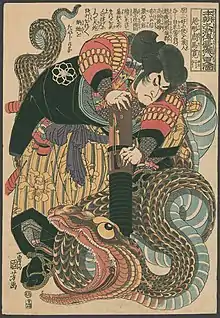
The "legendary ninjas" of Konoha (木ノ葉の三忍, Konoha no Sannin?) are ninjas from Konoha, famous for their legendary strength.[102] They are the three ninjas trained by the 3rd Hokage: Jiraya, the toad hermit, Orochimaru, the ethically dubious scientist, and Tsunade the doctor ninja. Their mythical strength enables them to single-handedly topple an entire village or summon immense creatures: the Gamabunta toad for Jiraya, the Madanda snake for Orochimaru and the Katsuyu slug for Tsunade.[nb 9][103]
The Sannin title is more a common honorific than a rank in its own right. Indeed, the Sannin (lit. "the three ninjas") were so named by "Hanzô, the Salamander", former head of the Rain Village ("Soul"), because of their great power (they are the only survivors of his assault on a whole group of Konoha ninjas during the Great War between the villages) and their numbers. They are of a level equivalent to that of the kage: Tsunade became, against all odds, the 5th Hokage; Orochimaru defeated the 3rd Hokage, forcing him to sacrifice himself for his village; Jiraya, after Orochimaru's vengeful visit to Konoha and the death of his sensei, refused the post of Hokage offered to him by the village's council of elders, preferring to leave it to Tsunade.
During the two and a half years separating the two parts of the manga, each of the Sannin will train one of the young ninjas in Team 7, formed at the beginning of the manga: Jiraya will take charge of Naruto, Orochimaru will look after Sasuke, while Tsunade will take Sakura as her apprentice.[104]
Nukenin
Nukenin (抜け忍, Deserter ninjas?) are ninjas who have betrayed and fled their respective ninja village.[105] Since a hidden village is a military organization, it is forbidden to abandon it. They are hunted down by the oinin.
Nukenin are usually ninjas who have committed serious offences, such as attempted murder of a village resident, prohibited operations or failure to carry out a particular mission.
Sometimes, to symbolize their detachment from their place of origin, they keep their headbands, having taken care to cross out the symbol of their village[106] (as is the case for Akatsuki ninjas).
In Naruto's world, the most powerful nukenin have been brought together by Tobi and Pain to form the Akatsuki association.[107][108] Others sell themselves as mercenaries (e.g. Zabuza Momochi), or act on their own behalf (e.g. Orochimaru).
Examples of nukenin:
- Orochimaru;
- Kabuto Yakushi;
- Sasuke Uchiha (only in the 2nd part of the manga);
- Zabuza Momochi;
- Haku;
- Itachi Uchiha;
- Kisame Hoshigaki;
- Sasori;
- Deidara;
- Hidan;
- Kakuzu;
- Madara Uchiha;
- Utakata.
Oinin
Oinin (追い忍, hunter of deserters?) are ANBU with the special mission of tracking down and neutralizing the nukenin in order to protect the secrets of their village.[105]
Tracking down nukenin is of the utmost importance: the aim is to protect the secrets of their village, so that they don't reveal them to the enemy.
Once they've killed a nukenin, their task is to make the body and its secrets disappear, so that other villages can't recover any information. According to Kakashi Hatake, the end of a ninja is thus "soundless and odorless": no trace must be left behind.[105] The only part of the body retained is the head, to prove that the mission was a success.
Eiseinin

Eiseinin (衛生, doctor ninjas?) are ninjas with a good knowledge of medical techniques. Their main mission is to provide first aid to the wounded when their team is engaged in combat (and at the end of combat).
They are not usually in the front line of combat, as they must avoid being killed at all costs, so attacking is not their main task. To avoid being killed, a ninja medic must concentrate above all on avoiding being hit by opposing attacks.[109]
The technique behind medical ninjutsu is called the "Mystic Palm Technique" (掌仙術, Shōsen Jutsu?).[110] It is used to heal wounds and perform surgery. The user focuses his chakra (green in color) in his hand and applies it to the wound, accelerating cell regeneration. He can also focus his chakra into a blade to perform surgery when needed. Since this blade is made of chakra, the user doesn't need to cut through the body's skin to reach muscles and organs.
To practice medical ninjutsu with a healing side, a large amount of chakra is required. Cutting, on the other hand, seems to be less chakra-intensive.
This cutting aspect of the technique can also be used in combat, although it requires incredible precision and efficiency on the part of the user.
Beyond this technique, many ninja doctors in groups can use more powerful techniques to treat much more serious injuries.
Another facet of their work may be to compose antidotes against poisons that can be used by the opponent.
Tsunade belongs to this category of ninja. In fact, she campaigned for a ninja doctor to be assigned to each Konoha ninja team.
Surveillance team
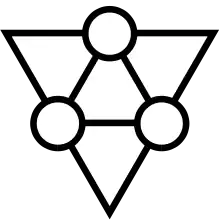
The surveillance team, or "barrier team", are ninjas charged with guarding the protective barrier surrounding the hidden village of Konoha. This barrier is spherical, and can be detected by the Rinnegan.[111] It protects Konoha from all sides, including underground intrusions. Intruders are detected immediately by a team specialist able to sense disturbances in the barrier and see exactly where the intrusion is taking place, thanks to a transparent spherical miniature floating in the protection team room. The cap of the main sensor and two other sensors beside it bear the symbol of the protection team, in addition to the protector bearing the symbol of Konoha. The main sensor also bears specific markings on his face.[111]
Once an intrusion has been detected, the sensor alerts the rest of the team, made up of five ninja factions, and tells them the area where the intrusion is taking place, in the form of two letters. If the intruders are too numerous or too powerful, these ninjas are also responsible for notifying the Hokage to put the village on alert. These ninjas also wear the protection team symbol on their right shoulder.[111]
When Pain attacks the village, a Hyûga is part of the protection team, so that the Byakugan can quickly determine the extent of the invasion and act accordingly.[111]
ANBU or former ANBU (like Itachi) know a priori how to cross the barrier undetected, which explains why the intrusion of Itachi Uchiha and Kisame Hoshigaki went unnoticed after the death of the 3rd Hokage.[111]
Ninja Gear

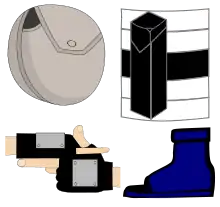
In the Naruto universe, ninjas are far from their usual representation. According to Masashi Kishimoto, it was to avoid the failure of all previous manga about ninjas that he added this touch of originality, rejecting all preconceived ideas about ninjas (balaclavas, black equipment...). He found it amusing that a young blond boy in orange clothes could be part of an intelligence-gathering organization.[8]
However, these ninjas use many conventional weapons.
Here's the standard equipment for a ninja in the Naruto universe:
- headband consisting of a metal plate engraved with the village insignia, combined with a band to tie around the forehead (but which can be worn differently, or riveted to another garment);
- shurikens;
- kunai;
- invocation scrolls and writing materials;
- rope;
- bandages;
- explosive scrolls;
- scroll pouches;
- shuriken case;
- steel wire;
- smoke grenades.
Other weapons or equipment may be used by certain ninjas... Non-exhaustive list:
- saber;
- makibishis;
- senbons;
- brass knuckles;
- fan;
- poisons / antidotes;
- soldier's pills: medical pills composed of proteins and stimulants that momentarily increase chakra and are reputed to give a ninja enough energy to fight for 72 hours without rest.[112]
Types of missions
.svg.png.webp)
The missions assigned to ninjas fall into five categories, depending on the skills required and the risks involved.[113]
In the second volume, the 3rd Hokage explains how the mission system works:[77]
"The village receives many requests every day. The range is very wide, from babysitting to assassination. We draw up a list of these various missions and then divide them into five categories S, A, B, C and D, according to their level of difficulty. The village's ninjas are also ranked in a hierarchy according to their abilities. I'm at the top, then we move on to the jōnins, the chūnins, and at the very bottom, the genins. It's up to those at the top to distribute missions to the other ninjas according to their respective abilities. Finally, when the mission has been well accomplished, the applicant pays us a fee: that's the whole process."
These are the assignments given in normal times. In Konoha, after Orochimaru's offensive, during which many ninjas died, the lack of manpower meant that sensitive missions had to be allocated to less experienced ninjas. Thus, the Shikamaru-Naruto-Neji-Kiba-Chôji team, made up of genin and chūnin, is given the mission of recovering Sasuke even though it's an A-rank mission...[114] Moreover, realizing the danger of the mission, Tsunade dispatches two medical teams as a matter of urgency, and even has to call on Suna, who sends Gaara's team as reinforcements.[115] Even Kakashi Hatake will come to the rescue, with the help of his ninja dogs.[116]
Rank D missions
These are the less difficult missions. They mainly involve services rendered to villagers: plowing fields, pulling weeds, walking domestic animals, and so on. They are generally given to new aspirants (genin) so that they can learn to get along and work as a team.
Rank C missions
These missions involve leaving the village. They may involve escorting people or delivering harmless documents. Although these missions involve little risk of fighting assailants, they do require a little more experience. They are therefore conceded to seasoned genin or newly promoted chūnin.
Rank B missions
These charges are more arduous and perilous. They carry a high risk of encountering belligerents. They involve escorting personalities threatened with death or delivering confidential documents. They are consequently entrusted to experienced chūnin or jōnin.
Rank A missions
These extremely dangerous missions are of the utmost importance. For this reason, they are carried out by highly experienced ninjas such as jōnin and ANBU. They carry out the most delicate tasks, such as assassinations, daimyō escorts and espionage missions.
Rank S missions
This is the ultimate level of mission. Consequently, only the best ninjas in a country can accomplish these tasks. S-rank missions differ from A-rank missions in that they have an almost vital impact on the continued existence of the hidden village. They are commonly carried out by jōnin, ANBU or, on rare occasions, by the kage himself. These missions may involve espionage, assassination or the arrest of S-rank criminals, such as members of the Akatsuki.
Bibliographie
- Kazuhisa Fujie, Naruto Forever: The Unofficial Guide, DH Publishing, 2008, 191 p. (ISBN 978-1-93-289725-8, read online archive)
Databooks
- (ja) Masashi Kishimoto, NARUTO - Hiden Rin no Sho (NARUTO―ナルト―[秘伝・臨の書]?): Characters Official Data Book (キャラクターオフィシャルデータBOOK?), Tōkyō, Shūeisha, coll. "Jump Comics (ジャンプコミックス, Janpu Comikkusu?) / Naruto", 4 July 2002, 272 p., shinsho (新書?) / Tankōbon / 175x115mm (ISBN 4-08-873288-X and 978-4-08-873288-6, online presentation [archive])
- (ja) Masashi Kishimoto, NARUTO - Hiden Tō no Sho (NARUTO―ナルト―[秘伝・闘の書]?): Characters Official Data Book (キャラクターオフィシャルデータBOOK?), Tōkyō, Shūeisha, coll. "Jump Comics (ジャンプコミックス, Janpu Comikkusu?) / Naruto", 4 April 2005, 320 p., shinsho (新書?) / Tankōbon / 175x115mm (ISBN 4-08-873734-2 and 978-4-08-873734-8, online presentation archive)
- (ja) Masashi Kishimoto, NARUTO - Hiden Sha no Sho (NARUTO―ナルト―[秘伝・者の書]?): Characters Official Data Book (キャラクターオフィシャルデータBOOK?), Tōkyō, Shūeisha, coll. "Jump Comics (ジャンプコミックス, Janpu Comikkusu?) / Naruto", 4 September 2008, 360 p., shinsho (新書?) / Tankōbon / 175x115mm (ISBN 978-4-08-874247-2, online presentation archive)
Fanbooks
- (ja) Masashi Kishimoto, NARUTO - Hiden Hyō no Sho (NARUTO―ナルト―[秘伝・兵の書]?): Official Fan Book (オフィシャルファンBOOK?), Tōkyō, Shūeisha, coll. "Jump Comics (ジャンプコミックス, Janpu Comikkusu?) / Naruto", 4 October 2002, 282 p., shinsho (新書?) / Tankōbon / 175x115mm (ISBN 4-08-873321-5 and 978-4-08-873321-0, online presentation archive)
- (ja) Masashi Kishimoto, NARUTO - Hiden Kai no Sho (NARUTO-ナルト-[秘伝・皆の書]?): Official Premium Fan Book (オフィシャルプレミアムファンBOOK?), Tōkyō, Shūeisha, coll. "Jump Comics (ジャンプコミックス, Janpu Comikkusu?) / Naruto", 4 December 2009, 256 p., shinsho (新書?) / Tankōbon / 175x115mm (ISBN 978-4-08-874834-4, online presentation archive)
Artbooks
- Masashi Kishimoto, The Art of Naruto: Uzumaki, VIZ Media, coll. "Art of Shonen Jump / Naruto", 25 October 2007, 145 p., Artbook (relié) / 215x305mm (ISBN 978-1-4215-1407-9, online presentation archive)
- (ja) Masashi Kishimoto, NARUTO - Illustration Shū NARUTO (NARUTO-ナルト-イラスト集 NARUTO?), Tōkyō, Shūeisha, coll. "Jump Comics (ジャンプコミックス, Janpu Comikkusu?) / Naruto", 3 July 2009, 106 p., A4 / Artbook / 210x297mm (ISBN 978-4-08-874823-8, online presentation archive)
In French
- (fr) Masashi Kishimoto (trad. Sylvain Chollet), Naruto tome 1: Naruto Uzumaki !!, Kana, coll. "Shonen Kana / Naruto", 9 March 2002, 192 p., Tankōbon / 115x175mm (ISBN 2-87129-414-3 and 978-2-87129-414-6, online presentation archive)
- (fr) Masashi Kishimoto (trad. Sylvain Chollet), Naruto tome 2: Un client embarrassant, Kana, coll. "Shonen Kana / Naruto", 13 April 2002, 208 p., Tankōbon / 115x175mm (ISBN 2-87129-417-8 and 978-2-87129-417-7, online presentation archive)
- (fr) Masashi Kishimoto (trad. Sylvain Chollet), Naruto tome 4: Le pont des héros?, Kana, coll. "Shonen Kana / Naruto", 19 October 2002, 192 p., Tankōbon / 115x175mm (ISBN 2-87129-441-0 and 978-2-87129-441-2, online presentation archive)
- (fr) Masashi Kishimoto (trad. Sylvain Chollet), Naruto tome 8: Au péril de sa vie !!, Kana, coll. "Shonen Kana / Naruto", 11 October 2003, 198 p., Tankōbon / 115x175mm (ISBN 2-87129-552-2 and 978-2-87129-552-5, online presentation archive)
- (fr) Masashi Kishimoto (trad. Sylvain Chollet), Naruto tome 9: Neji et Hinata, Kana, coll. "Shonen Kana / Naruto", 10 January 2004, 192 p., Tankōbon / 115x175mm (ISBN 2-87129-599-9 and 978-2-87129-599-0, online presentation archive)
- (fr) Masashi Kishimoto (trad. Sylvain Chollet), Naruto tome 10: Un ninja formidable... !!, Kana, coll. "Shonen Kana / Naruto", 20 March 2004, 192 p., Tankōbon / 115x175mm (ISBN 2-87129-614-6 and 978-2-87129-614-0, online presentation archive)
- (fr) Masashi Kishimoto (trad. Sébastien Bigini), Naruto tome 11: Mon nouveau prof !!, Kana, coll. "Shonen Kana / Naruto", 1 May 2004, 192 p., Tankōbon / 115x175mm (ISBN 2-87129-624-3 and 978-2-87129-624-9, online presentation archive)
- (fr) Masashi Kishimoto (trad. Sébastien Bigini), Naruto tome 12: L’oiseau s’est envolé... !!, Kana, coll. "Shonen Kana / Naruto", 3 July 2004, 192 p., Tankōbon / 115x175mm (ISBN 2-87129-635-9 and 978-2-87129-635-5, online presentation archive)
- (fr) Masashi Kishimoto (trad. Sébastien Bigini), Naruto tome 14: Hokage contre Hokage !!, Kana, coll. "Shonen Kana / Naruto", 20 November 2004, 192 p., Tankōbon / 115x175mm (ISBN 2-87129-657-X and 978-2-87129-657-7, online presentation archive)
- (fr) Masashi Kishimoto (trad. Sébastien Bigini), Naruto tome 16: La bataille de Konoha, dernier acte !!, Kana, coll. "Shonen Kana / Naruto", 4 March 2005, 192 p., Tankōbon / 115x175mm (ISBN 2-87129-723-1 and 978-2-87129-723-9, online presentation archive)
- (fr) Masashi Kishimoto (trad. Sébastien Bigini), Naruto tome 17: La puissance d’Itachi !!, Kana, coll. "Shonen Kana / Naruto", 6 May 2005, 192 p., Tankōbon / 115x175mm (ISBN 2-87129-776-2 and 978-2-87129-776-5, online presentation archive)
- (fr) Masashi Kishimoto (trad. Sébastien Bigini), Naruto tome 18: La décision de Tsunade !!, Kana, coll. "Shonen Kana / Naruto", 1 July 2005, 192 p., Tankōbon / 115x175mm (ISBN 2-87129-797-5 and 978-2-87129-797-0, online presentation archive)
- (fr) Masashi Kishimoto (trad. Sébastien Bigini), Naruto tome 19: Le successeur, Kana, coll. "Shonen Kana / Naruto", 2 September 2005, 192 p., Tankōbon / 115x175mm (ISBN 2-87129-816-5 and 978-2-87129-816-8, online presentation archive)
- (fr) Masashi Kishimoto (trad. Sébastien Bigini), Naruto tome 21: Sans pitié !!, Kana, coll. "Shonen Kana / Naruto", 20 January 2006, 216 p., Tankōbon / 115x175mm (ISBN 2-87129-890-4 and 978-2-87129-890-8, online presentation archive)
- (fr) Masashi Kishimoto (trad. Sébastien Bigini), Naruto tome 22: Réincarnation... !!, Kana, coll. "Shonen Kana / Naruto", 3 March 2006, 192 p., Tankōbon / 115x175mm (ISBN 2-87129-911-0 and 978-2-87129-911-0, online presentation archive)
- (fr) Masashi Kishimoto (trad. Sébastien Bigini), Naruto tome 23: Crise... !!, Kana, coll. "Shonen Kana / Naruto", 5 May 2006, 192 p., Tankōbon / 115x175mm (ISBN 2-87129-931-5 and 978-2-87129-931-8, online presentation archive)
- (fr) Masashi Kishimoto (trad. Sébastien Bigini), Naruto tome 24: Tournant décisif !!, Kana, coll. "Shonen Kana / Naruto", 7 July 2006, 192 p., Tankōbon / 115x175mm (ISBN 2-87129-961-7 and 978-2-87129-961-5, online presentation archive)
- (fr) Masashi Kishimoto (trad. Sébastien Bigini), Naruto tome 25: Itachi et Sasuke, Kana, coll. "Shonen Kana / Naruto", 1 September 2006, 192 p., Tankōbon / 115x175mm (ISBN 2-87129-977-3 and 978-2-87129-977-6, online presentation archive)
- (fr) Masashi Kishimoto (trad. Sébastien Bigini), Naruto tome 26: Séparation... !!, Kana, coll. "Shonen Kana / Naruto", 17 November 2006, 192 p., Tankōbon / 115x175mm (ISBN 2-87129-987-0 and 978-2-87129-987-5, online presentation archive)
- (fr) Masashi Kishimoto (trad. Sébastien Bigini), Naruto tome 27: Le jour du départ !!, Kana, coll. "Shonen Kana / Naruto", 19 January 2007, 192 p., Tankōbon / 115x175mm (ISBN 978-2-5050-0031-0, online presentation archive)
- (fr) Masashi Kishimoto (trad. Sébastien Bigini), Naruto tome 29: Kakashi versus Itachi !, Kana, coll. "Shonen Kana / Naruto", 4 May 2007, 192 p., Tankōbon / 115x175mm (ISBN 978-2-5050-0097-6, online presentation archive)
- (fr) Masashi Kishimoto (trad. Sébastien Bigini), Naruto tome 30: Chiyo et Sakura, Kana, coll. "Shonen Kana / Naruto", 6 July 2007, 192 p., Tankōbon / 115x175mm (ISBN 978-2-5050-0152-2, online presentation archive)
- (fr) Masashi Kishimoto (trad. Sébastien Bigini), Naruto tome 31: Testament !!, Kana, coll. "Shonen Kana / Naruto", 7 September 2007, 192 p., Tankōbon / 115x175mm (ISBN 978-2-5050-0167-6, online presentation archive)
- (fr) Masashi Kishimoto (trad. Sébastien Bigini), Naruto tome 35: Un nouveau duo !!, Kana, coll. "Shonen Kana / Naruto", 4 April 2008, 208 p., Tankōbon / 115x175mm (ISBN 978-2-5050-0296-3, online presentation archive)
- (fr) Masashi Kishimoto (trad. Sébastien Bigini), Naruto tome 36: L’unité 10, Kana, coll. "Shonen Kana / Naruto", 6 June 2008, 192 p., Tankōbon / 115x175mm (ISBN 978-2-5050-0323-6, online presentation archive)
- (fr) Masashi Kishimoto (trad. Sébastien Bigini), Naruto tome 37: Le combat de Shikamaru !!, Kana, coll. "Shonen Kana / Naruto", 4 July 2008, 192 p., Tankōbon / 115x175mm (ISBN 978-2-5050-0378-6, online presentation archive)
- (fr) Masashi Kishimoto (trad. Sébastien Bigini), Naruto tome 38: Le fruit de l’entraînement... !!, Kana, coll. "Shonen Kana / Naruto", 19 September 2008, 192 p., Tankōbon / 115x175mm (ISBN 978-2-5050-0432-5, online presentation archive)
- (fr) Masashi Kishimoto (trad. Sébastien Bigini), Naruto tome 41: Le choix de Jiraya !!, Kana, coll. "Shonen Kana / Naruto", 19 April 2009, 192 p., Tankōbon / 115x175mm (ISBN 978-2-5050-0558-2, online presentation archive)
- (fr) Masashi Kishimoto (trad. Sébastien Bigini), Naruto tome 43: Celui qui sait, Kana, coll. "Shonen Kana / Naruto", 21 August 2009, 240 p., Tankōbon / 115x175mm (ISBN 978-2-5050-0670-1, online presentation archive)
- (fr) Masashi Kishimoto (trad. Sébastien Bigini), Naruto tome 44: Traditions d’ermites... !!, Kana, coll. "Shonen Kana / Naruto", 23 October 2009, 192 p., Tankōbon / 115x175mm (ISBN 978-2-5050-0711-1, online presentation archive)
- (fr) Masashi Kishimoto (trad. Sébastien Bigini), Naruto tome 45: Konoha, théâtre de guerre !!, Kana, coll. "Shonen Kana / Naruto", 4 December 2009, 192 p., Tankōbon / 115x175mm (ISBN 978-2-5050-0754-8, online presentation archive)
- (fr) Masashi Kishimoto (trad. Sébastien Bigini), Naruto tome 46: Le retour de Naruto !!, Kana, coll. "Shonen Kana / Naruto", 15 January 2010, 192 p., Tankōbon / 115x175mm (ISBN 978-2-5050-0788-3, online presentation archive)
- (fr) Masashi Kishimoto (trad. Sébastien Bigini), Naruto tome 47: La libération du sceau !!, Kana, coll. "Shonen Kana / Naruto", 5 March 2010, 192 p., Tankōbon / 115x175mm (ISBN 978-2-5050-0869-9, online presentation archive)
- (fr) Masashi Kishimoto (trad. Sébastien Bigini), Naruto tome 49: Le Conseil des Cinq Kage... !!, Kana, coll. "Shonen Kana / Naruto", 2 July 2010, 192 p., Tankōbon / 115x175mm (ISBN 978-2-5050-0871-2, online presentation archive)
- (fr) Masashi Kishimoto (trad. Sébastien Bigini), Naruto tome 50: Duel à mort dans la prison aqueuse !!, Kana, coll. "Shonen Kana / Naruto", 3 September 2010, 192 p., Tankōbon / 115x175mm (ISBN 978-2-5050-0956-6, online presentation archive)
In Japanese
- (ja) Masashi Kishimoto, NARUTO - 41 (NARUTO―ナルト― 41?): Jiraiya no Sentaku!! (自来也の選択!!?), Shūeisha, coll. "Jump Comics (ジャンプコミックス, Janpu Comikkusu?) / Naruto", 4 February 2008, 192 p., shinsho (新書, shinsho?) / Tankōbon / 175x115mm (ISBN 978-4-08-874472-8, online presentation archive)
- (ja) Masashi Kishimoto, NARUTO - 54 (NARUTO―ナルト― 54?): Heiwa e no kakehashi (平和への懸け橋?), Shūeisha, coll. "Jump Comics (ジャンプコミックス, Janpu Comikkusu?) / Naruto", 29 December 2010, 192 p., shinsho (新書, shinsho?) / Tankōbon / 175x115mm (ISBN 978-4-08-870143-1, online presentation archive)
Notes
- See related articles for more details.
- The techniques of the Hyûga clan and their kekkei genkai, the Byakugan, are entirely based on this principle.
- In this case, the fifth element kū (空, the void or the sky) is replaced by another reminiscent of it: lightning.
- In the case of certain kekkei genkai, there is sometimes a second affinity. What's more, a ninja sometimes develops a second, weaker affinity for a second element over time.
- The wood used to make it comes from a tree that has been "fed" the chakra all its life.
- The ninja military villages of Naruto's world are not "hidden" in the literal sense; this appellation comes from the suffix attached to the name of the village in the original version -gakure (e.g. Konohagakure no Sato (木ノ葉隠れの里, lit. Village hidden in the leaves).
- In the second half of the manga, however, we see some fairly modern weapons used by Shuradô, one of Pain's avatars, but this was a one-off and the character only appeared for a short part of the narrative.
- Another kage, the Hoshikage of the Hidden Village of the Star, is featured in a filler arc of the anime, a self-proclaimed kage who is not recognized by the other kage (Naruto anime, episodes 178 to 183).
- Jiraiya, Orochimaru, and Tsunade are three characters from the Japanese tale Jiraiya Goketsu Monogatari, where the symbolism of the toad, the slug, and the snake can be found.
- The circled kanji in the medical team symbol is I (医, lit. Medicine).
- The headband also protects the ninja's forehead.
- Shuriken in the Naruto manga can be particularly large, as can be seen in the very first episode (Volume 1, episode 1).
- The kanji visible in the center of the explosive scrolls is Baku (爆, lit. Explosion).
- Senbons can be coated with poison to make them more effective (Tome 18, episode 156). They can also be used to put a person in a state of apparent death (Tome 2, episode 17).
- Large shurikens with four deployable blades are also used by some ninjas, such as Sasuke Uchiwa (Volume 2, episode 14).
- This shuriken is summoned from a scroll and used by Naruto against Sasori (Volume 30, episode 264).
- The brass knuckles used by Asuma Sarutobi have a special feature: they can absorb the user's chakra (Volume 35, episode 317).
References
- 1st Artbook, p. 138.
- 1st Artbook, p. 127.
- 1st Artbook, p. 117.
- 1st Artbook, p. 123.
- 1st Artbook, p. 128.
- 1st Artbook, p. 132.
- 1st Artbook, p. 141.
- narutocentral.com, "Masashi Kishimoto Interview - Naruto Information" archive, on NarutoCentral (accessed January 15, 2010)
- 1st Artbook, p. 71.
- 1st Artbook, p. 94-95.
- 1st Artbook, p. 133.
- 1st Artbook, p. 146.
- 1st Artbook, p. 100-101.
- 1st Artbook, p. 134.
- 1st Artbook, p. 145.
- 1st Artbook, p. 107.
- 1st Artbook, p. 135.
- "Shonen Jump #33 Volume 3, Issue 9", Shōnen Jump, VIZ Media, no. 33 (vol. 3), September 2005, p. 8 (ISSN 1545-7818)
- (fr) Tome 9, episode 79.
- (ja) 1st Databook, p. 155.
- (fr) Tome 38, episode 346.
- (fr) Tome 2, episode 17.
- (ja) 1st Fanbook, p. 160.
- (fr) Tome 17, episode 151.
- (fr) Tome 10, episode 85.
- (fr) Tome 35, episode 314.
- (ja) 3rd Databook, p. 214-215.
- (fr) Tome 37, episode 333.
- (ja) 3rd Databook, p. 214.
- (fr) Tome 35, episode 315.
- (ja) 3rd Databook, p. 215.
- (fr) Tome 35, episode 316.
- (ja) 3rd Databook.
- (ja) 3rd Databook, p. 216.
- (fr) Tome 36, episode 321.
- (fr) Tome 36, episode 329.
- Naruto's mastery of the Fūton affinity
- (fr) Tome 23, episode 207.
- (fr) Tome 41, episode 370.
- (fr) Tome 44, episode 410.
- (fr) Tome 45, episode 420.
- Ramsey Isler, "Top Ten Naruto Techniques - Page 1" archive, on IGN, December 14, 2007 (accessed January 15, 2010)
- (ja) 1st Databook, p. 162-227.
- (ja) 2nd Databook, p. 198-285.
- (ja) 3rd Databook, p. 222-313.
- (ja) 1st Databook, p. 220.
- (ja) 1st Databook, p. 177.
- (ja) 1st Databook, p. 211.
- (ja) 1st Databook, p. 156.
- (ja) 1st Fanbook, p. 161-163.
- (fr) Tome 11, episode 92.
- (ja) 1st Databook, p. 160-161.
- (ja) 1st Databook, p. 159.
- (fr) Tome 45, episode 417
- (fr) Tome 45, episode 418.
- (fr) Tome 45, episode 415.
- (fr) Tome 46, episode 425.
- (fr) Tome 47, episode 433.
- (ja) 1st Databook, p. 157.
- (fr) Tome 29, episode 259.
- (fr) Tome 9, episode 78.
- (fr) Tome 12, episode 101.
- (fr) Tome 22, episode 194.
- (ja) 1st Databook, p. 158.
- (fr) Tome 8, episode 69.
- (fr) Tome 17, episode 148.
- Pre-published episode 646.
- Pre-published episode 670.
- (fr) Tome 41, episode 373.
- (ja) Tome 54, episode 510.
- (fr) Tome 49, episode 462.
- (fr) Tome 50, episode 467.
- Pre-published episode 527.
- (fr) Tome 29, episode 256.
- (ja) 3rd Databook, p. 198-199.
- (fr) Tome 29, episode 261.
- (fr) Tome 2, episode 9.
- "World Map - The Village Hidden in the Leaves" archive, on VIZ Media (accessed April 28, 2010)
- (fr) Tome 8, episode 65.
- (fr) Tome 1
- (fr) Tome 26, episode 235.
- (ja) 2nd Databook, p. 247.
- (fr) Tome 37, episode 330.
- (fr) Tome 1, episode 1.
- (fr) Tome 2, episode 14.
- (fr) Tome 1, episode 3.
- (fr) Tome 1, episode 4.
- (fr) Tome 1, episode 8.
- (fr) Tome 43, episode 399.
- (fr) Tome 25, episode 220.
- (fr) Tome 25, episode 222.
- (fr) Tome 25, episode 224.
- (fr) Tome 4, episode 35.
- (ja) 1st Fanbook, p. 121.
- Fujie, pp. 20-21
- (ja) 1st Databook, p. 22.
- (ja) 3rd Databook, p. 202.
- (ja) 3rd Databook, p. 203.
- (fr) Tome 49, episode 457.
- (fr) Tome 14, Front cover.
- (fr) Tome 49, Front cover.
- (ja) 2nd Databook, p. 174-175.
- (fr) Tome 19, episode 170.
- (fr) Tome 27, episode 238.
- (fr) Tome 2, episode 16.
- (fr) Tome 16, episode 141.
- (ja) 2nd Databook, p. 180-181.
- (ja) 3rd Databook, p. 196-197.
- (fr) Tome 30, episode 270.
- (ja) 1st Databook, p. 198.
- (fr) Tome 45, episode 419.
- (fr) Tome 9, episode 76.
- (ja) 1st Fanbook, p. 120.
- (fr) Tome 21, episode 182.
- (fr) Tome 24, episode 213.
- (fr) Tome 26, episode 228.

